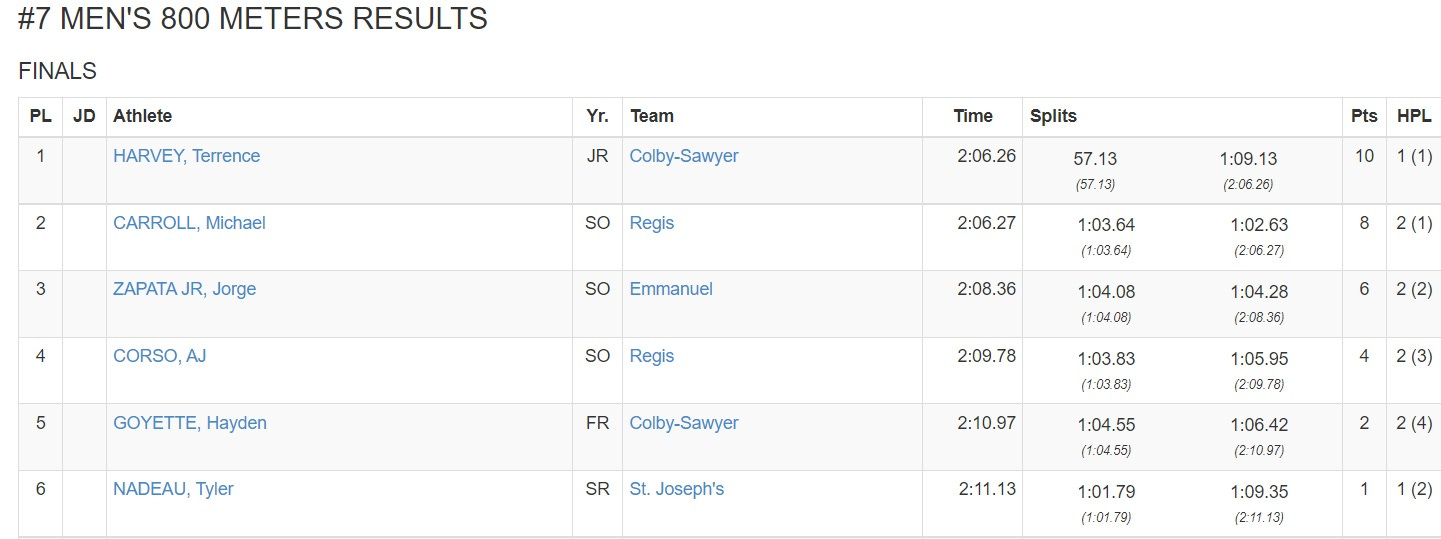So it's May, and spring track started a while ago
Another hometown record chase, the 10,000m races at Payton Jordan, what it takes to be a 1-percenter in Philadelphia, and being made a proud uncle (again)
Despite access to a calendar and multiple Internet-connected devices, I refuse at some level to accept that outdoor track is always well underway by the beginning of May.
There is some legitimacy to this viewpoint, albeit in a parochial sense. I grew up in New Hampshire, coached at a high school in my hometown for a few years, and still keep a close eye on prep running there; because the weather is generally unfavorable until early May, I don’t bother looking at New Hampshire performance lists until, say, early May, which it now seems to be. I ran new personal bests in the 3,200 meters as both a junior and a senior in the final races of those seasons, both held in June. In addition, the U.S. Olympic Trials and the U.S. National Outdoor Championships usually start in late June, though these have fuck-all to do with scholastic running. All of this has led me to unconsciously expand this dismissal of March and April outdoor track action to the entire country, most of which does not exhibit a northern New England-style climate.
Besides, it seems I’m easily distracted from actual running by the various sideshows that have sprung up like meth-rich homeless encampments around and within the sport’s borders.
But I just checked, and people have been entering and running track races all over the country. So it’s probably time to identify and develop some story lines in that realm, and hope like hell this chore doesn’t make serious inroads into the more important work of continually urinating on running’s poolside bullshit-parties in rotating fashion from an electronic balcony.
Last spring, I wrote extensively about Eben Bragg, the son of a high-school teammate and friend, and his flirtation with the Concord High 1600m record from 1987 en route to becoming the state champion in that event. If you read any of that stuff, you may recall controversy over whether Bragg, who ran 4:15.61 and 4:15.65, in fact wound up surpassing Chris Basha's mark of 4:15.5 because of the changes in timing technology and conflicting rules between high-school athletic authorities for converting hand-times to FAT.
A CHS record that stood for 34 years (and may still actually stand) may last only one year before its next reset. Senior Sam Hilts has been working hard at this sport for a long time—I met him after the NH Meet of Champs in XC in 2019, and the way he asked questions reminded me of me at 15, although that was before Hilts unleashed the magnificent manbun he now offers to his pursuers.
Conditions for the boys’ 1,600 meters at the Black Bear Invitational on Saturday were somewhat windy, though not unusually so for New Hampshire in April.
Hilts’ teammate John Murphy ran 4:23 last spring and has a great shot at running under 4:15.5/4:15.61 himself, and winning the 2022 Meet of Champions in early June—and probably the Division I State Meet the weekend before—will probably require a time better than 4:15 given honest pacing.
Coe-Brown Academy senior Aidan Cox ran his first outdoor distance race of 2022 after capping off his cross-country with a 14:18 for seventh place at the Garmin RunningLane XC Nationals in December and a vastly scaled back indoor season, when he ran 8:30 for 3,000 meters. This is the kid who has been beating much older runners since he was 8 years old, and now, as it inevitably would, it's actually happening to him.
Cox was beaten pretty soundly on Saturday by a sophomore from Phillips Exeter named Byron Grevious, who had run 9:04.27 for 12th place at the New Balance Indoor Nationals in March. Cox won't have to race that kid at any state-level championship meets because PE is a private school, but he hates losing, tends to only do it when it doesn’t matter much, and usually responds by breaking the entire field’s balls in the middle of the next competition. And hearkening to my comment about when track season really starts, in New Hampshire, Cox no doubt has his eyes on meets spanning late May to mid-June.
On Friday Night at the Payton Jordan Invitational, held at Stanford University on the other side of the country, three guys from the Cardinal ran 27:47 or better in the 10,000m, which I doubted had ever been done by a college trio. But forty years ago this week, three Kenyans from UTEP ran 27:36, 27:38 and 27:38 in the same race.
Charles Hicks is British (but went to high school in Florida) and Ky Robinson is Australian. But Sprout is an American from the Denver area, and I have written about him too. (Last spring, Podium Runner deleted that story and the nine other pieces I'd written for PR thanks to my persistently dickishly earnest reviews of other writers' work and the ascendant power of other people contacting the appropriate authorities whenever the truth threatens to scuttle their Wokish screeching.)
Sprout is now the #5 U.S. collegian ever in the event, behind Chris Derrick, Galen Rupp, Dathan Ritzenhein, and Conner Mantz. Not bad company (Mantz just graduated from BYU last year, and is already the reigning U.S. half-marathon champ). I really like that kid. He was brought along at a very reasonable pace for his talent level in high school despite a lot of eyes on him. 27:42 is worth around 13:13 for 5,000 meters, for which his best time is 13:24, so, superspikes or not, he just made a nice jump (or found his best event—this was his first-ever track 10,000m.
In the women's 10,000m, Keira D'Amato got second to a Chinese with the unlikely name of WuGa He. (WOO-ga WOO-ga WOO-ga-ga-ga! Isn't that some ancient football- or basketball-crowd chant?)
After a 2:19:12 marathon (5:18.6 pace) in January and with consistent training since, 31:50 (5:07.4 pace) should have felt like a breeze. D’Amato has run 5:08.3 pace for 10 miles on the roads, but 76-second laps on a nice soft track, with company, was tough? "Something" seems off here, but I can't quitE POsit what. I guess D’Amato is just really good at running 5:05 to 5:20 pace for however long whatever race she finds herself in happens to be, with her training never seeming to correlate very strongly with her results.
At the Broad Street Run yesterday in Philadelphia, 226 of the 20,276 finishers—1.1 percent of the herd—managed to break an hour for the 10-mile course. While this is a pure runway with no turns except for half a traffic circle that loses about 170’ of elevation, that seems impressive, even in idea conditions.
Jenna Mulhern, a senior from West Chester, Pa. who ran 16:07.5 on the track for 5,000 meters in March, ran 54:15 to place fourth overall among women.
That’s nice and all, but better was a pair of my friends most likely winning the unofficial penis-having parent/womb-possessing child division, traditionally expressed more concisely but in any case not an explicit awards category at this race.
I have run the BS10M course, though not all-out, and after studying the results for some years, it looks like a reasonably accurate conversion from a time at Broad Street to a loop course is simply taking your BS10 time in minutes and adding that number of seconds. For example, if you run 63:30 at Broad Street, adding 63 (or 64, to be conservative) seconds to this gives a legal-course time of 63:93, which is better understood if expressed as 64:33.
Also yesterday, my nephew Hayden, a freshman at Colby-Sawyer College in the happening part of New London, New Hampshire (both are which are really, really old places) ran three events at his conference championship meet. He was seeded sixth in both his events and got fifth in both, and took over five seconds off his best 1500 time by running 4:28.61. And his third-seeded 4 × 800m team took second.
So, he scored 2 + 2 + (8/4) = 6 points. And his team won the meet, which was at home, by six points over St. Joseph’s, 202-196.
1 and 2 in the 800m were separated by 0.01 seconds and were not in the same heat. Look at the difference in their pacing.
At the end of high school, Hayden’s best times for the 800m and mile (with the mile a converted time from a 1600) were 2:23.5 and 5:37.4. He ran consistently from the fall of his junior year onward, but was a late bloomer in a non-competitive team environment.
Now, less than a year later, those times (with the mile this time converted up from a 1,500m) are 2:07.4 and 4:50.1. If I get to run with him and his dad this summer, it will be a ridiculous joy not only going running with someone in my own family, but being unable to keep up if he wants to drop me.
And that seems like a nice place to stop. Outdoor track is about to begin!








